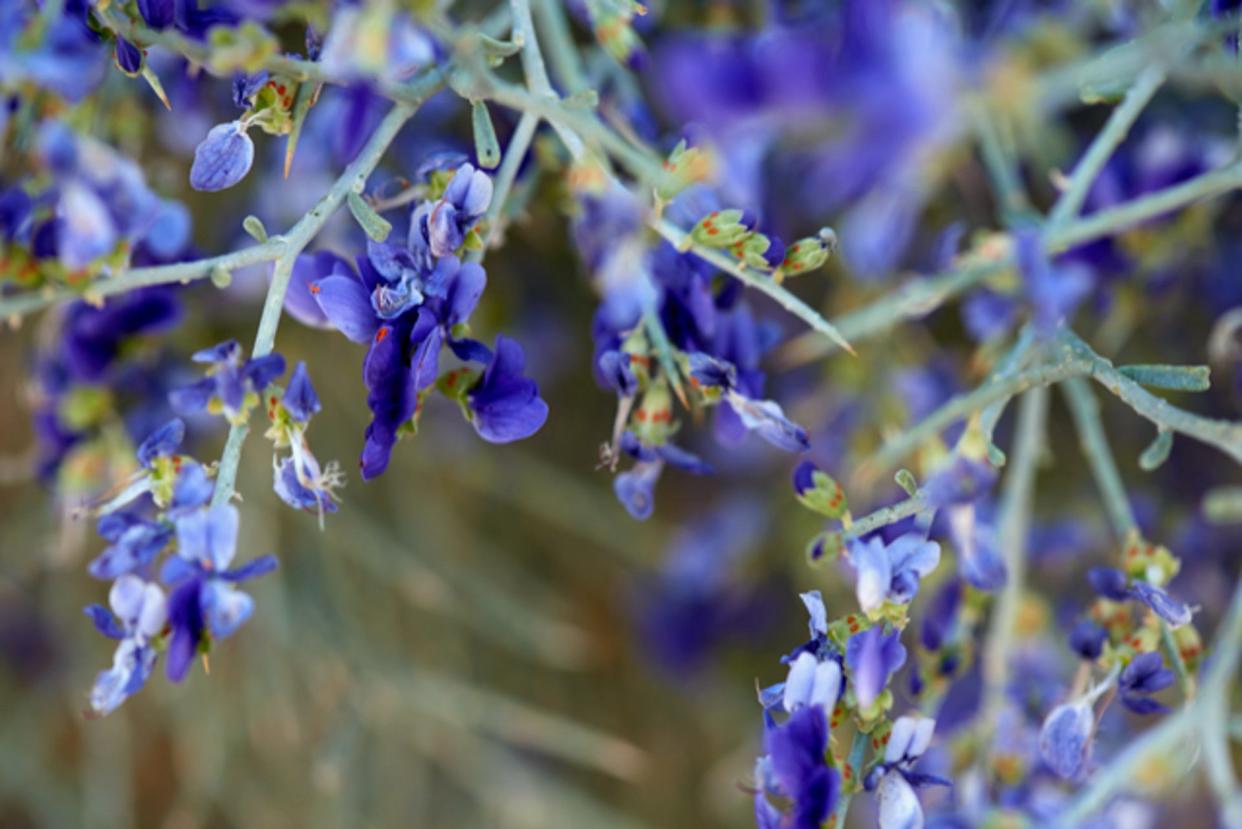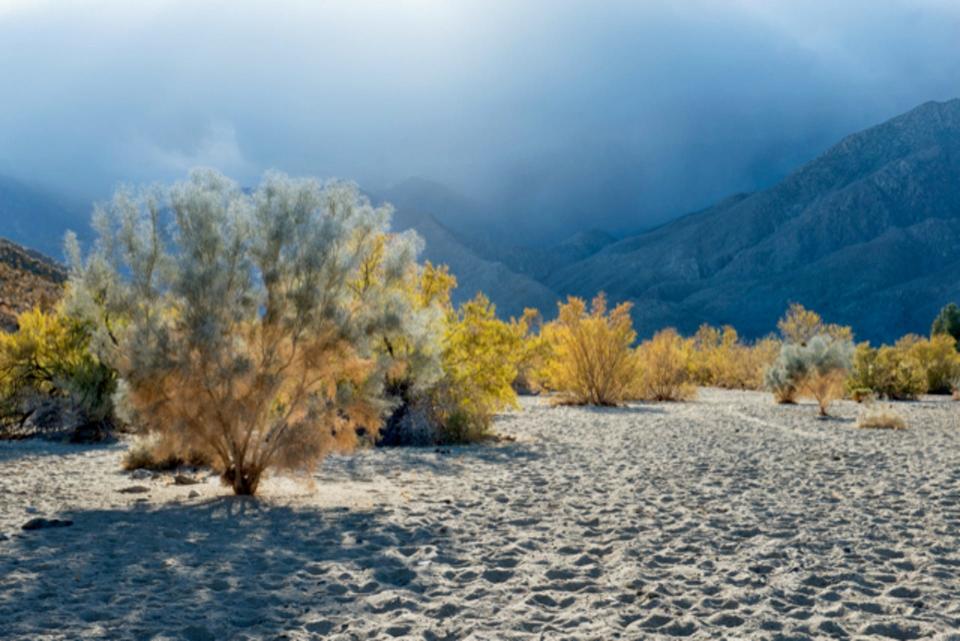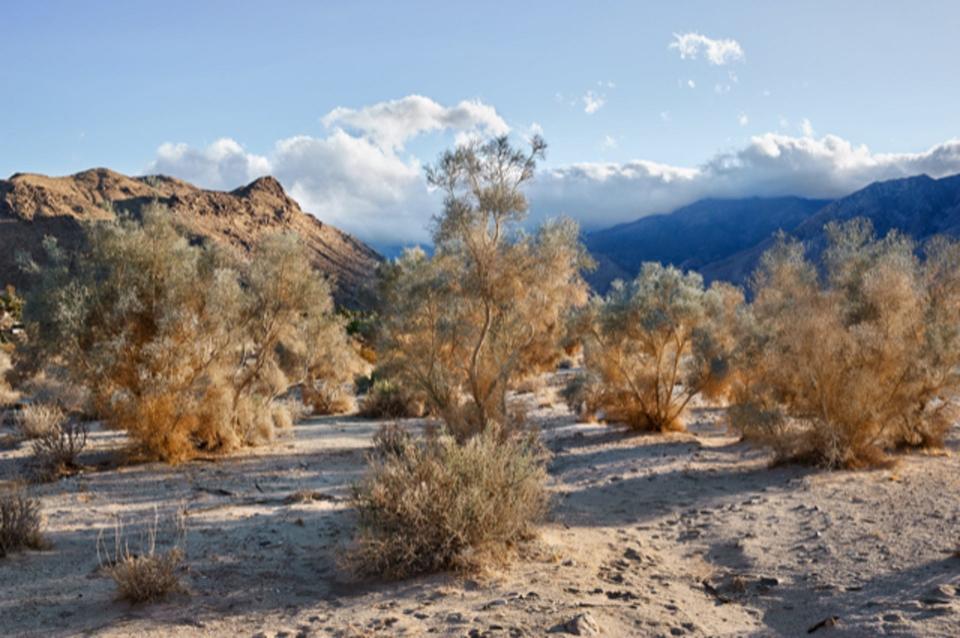Smoke trees are in bloom in the desert. Learn about the hardy, unusual specimen

- Oops!Something went wrong.Please try again later.
“To know the smoke tree is an experience; but one cannot know it at its strikingly best unless he has seen it in full flush of flower in June or early July, after the first blast of summer heat has driven visiting dilettanti back to the refrigerated comforts of coastal civilization. Then, the tiny, pea-shaped flowers, that have been described as pure ultramarine and as deep as violet-purple, appear in such profusion and in such unbelievable intensity of color that they actually obliterate all vision of the plant structure with a saturating deluge of brilliant pigment that can be seen from afar. Closer inspection also discloses a delicate perfume that further adds to the illusory charm of so unusual a plant.”
The indescribable purple color of the smoke tree was thus characterized by Ralph Cornell, the famous landscape architect and designer in 1938.
For centuries, purple has been the color of kings. (Queen Elizabeth I forbade anyone except close members of the royal family to wear purple. Its elite status likely stems from the rarity and cost of the dye originally used to produce it. But these humble desert trees burst out in a profusion of the most gorgeous shade of this now royal hue each summer and have done so for centuries, long before any human construct of hierarchies.)
Perhaps because of the color of the bloom, smoke trees have been revered on the desert.
Nellie Coffman, the owner and proprietor of The Desert Inn, excoriated anyone who even tampered with the trees. Cutting them down was against the law, an unwritten law, but one everyone in the desert knew the prohibition very well.
Only real desert rats, the bona fide locals, knew their secret. Most of the year, when tourists were visiting, the trees were unremarkable, even unattractive.
But, for a few brief weeks, generally in June just before the summer solstice, they bloom a glorious bluish purple in the tiniest of individual blossoms. The tree become alive with the buzz of bees, and after the bloom is over, a delicate carpet of purple surrounds driftwood-like trunks.

The California Garden and Landscape History Society produces a gorgeous quarterly journal (cglhs.org.) This spring’s edition features the desert smoke tree with an article written by editor Steven Keylon and illustrated by photographer Millicent Harvey, both of whom qualify at genuine desert rats.
The scholarly publication is appropriately entitled, “Eden,” as opening of any of its issues transports the reader to gardens reminiscent of the fabled paradise.
Keylon writes, “It is surprising to learn that the smoke tree is a member of the pea family (Faba-ceae.) Even more astonishing is the fact that so are most of the other trees native to the Coachella Valley. Don Admiral, the founder of the Palm Springs Desert Museum in 1938, was an admired naturalist, educator, native desert plant champion, and author of the book Desert of the Palms (1938). In a 1935 he explained: The trees of our desert are few in number but of a hardy strain, able to withstand the demands of life in a land where the unfitted succumb quickly. There are seven kinds that might be classified as native, six of these dwell in the sandy washes and waste places, the other requires a constant supply of water, hence is confined to the canyons and water holes. Of these seven, five—ironwood, Palo Verde, honey mesquite, smoke tree—belong to the pea family. It is remarkable that a single family, extensive as it is, should furnish such a large percent of the hardy desert trees.”
He notes that John Fremont, early California explorer, collected a smoke tree specimen in 1844.
On that same trip, Fremont found the Joshua Tree in the nearby high desert, writing in his diary that, “their stiff and ungraceful forms make them to the traveler the most repulsive tree in the vegetable kingdom.” The smoke tree wasn’t much too look at either, except when in bloom.
Keylon’s article discusses the artists who would remain in the desert, long past the desirable season, to see the spectacular summer show, referencing some of their canvases.
Almost every artist who came to or lived in the desert painted the subject. Carl Bray even gave himself the sobriquet of “Smoketree painter.” Stephen Willard produced many smoke tree images. Jimmy Swinterton, Carl Eytel, Paul Grimm, Gordon Coutts and Agnes Pelton all had a turn.

Keylon illustrates the Eden story with the modern images of photographer Millicent Harvey, who each June treks through the desert washes and up alluvial fans to capture the smoke tree show.
Harvey captures the delicate foliage and flowers, often backlit with the incomparable golden light of this desert, exposing the rarely seen beauty of these unusual trees.
As Ralph Cornell pointed out so long ago, to truly know the smoke tree is an experience, arguably a rare but requisite one for those who are true desert dwellers.
This story originally published on June 21, 2020.
This article originally appeared on Palm Springs Desert Sun: Smoke trees: A hardy, unusual example of desert beauty and magic

